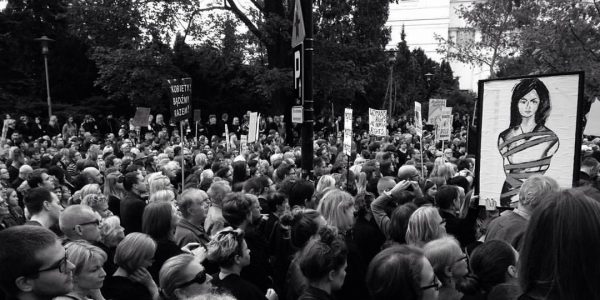Seven Million Women Dressed in Black

Poland has some of the most restrictive abortion laws in Europe — and they were about to get even more extreme. Last month, Polish politicians introduced legislation that would completely ban abortion, with only the smallest of exceptions.
But luckily, they had to contend with more than seven million activists.
Once feminists got wind of the proposed ban, they immediately began organizing protests. But the floodgates broke wide open when a politician dismissed the women, saying of them, “Let them have their fun.” In this largely Catholic country, lawmakers were not prepared for the backlash that was coming.
By the time the legislators voted on the proposed law, 7 million women had taken to the streets wearing all black in protest. Many women even walked out of work on what they called Black Monday. The women of Poland made a stand for their rights, and with the whole world watching, they won.
I caught up with Michalina Furtak, a Polish woman involved in the protests to learn what it was like and how it happened. Michalina also took the photo in this post.
Kelsey: What is your personal connection to this issue?
Misia: I feel that everyone has a connection to this issue, especially women.
K: How did you first hear about the protests? How did the word spread across the country?
M: I heard through Facebook. Social media played a big role. It started first as the #blackprotest spread through the outlets of RAZEM, a small left-wing political party. They wrote:
“On Wednesday, 20.09, the day when the parliament will begin to debate this regulation let’s dress in black. Each of us can manifest symbolically our opposition — at home, at work, on a walk, at school, on the Internet. Let us show that we do not agree to take away our the right to health, safety, dignity and respect. Let’s show our strength, our opposition, our solidarity. Take a photo, add to the event or post it on your wall using the #CzarnyProtest hashtag”
It was widely shared and talked about. It first lead to a protest on September 22, then to a much bigger and well prepared protest on October 3.
I think it was initiated by Inicjatywa Polska — a community organization. They also asked all political parties supporting the cause to show up without any banners or signs marking their political affiliation. They didn’t want the protest to be linked to one particular party. People got very involved — my friend asked a friend designer to support the protest by making a simple poster design, then she gather a small budget to pay for printing it from people interested, small donations but it was enough. People volunteered to put up the posters — it was special to see so many people engaged.
K: What was it like to be at the protests?
M: It was definitely an experience. There were really a lot of people and the weather was horrible on the Monday but the atmosphere was great despite that. It was hard to get to the main square, so many people were on their way that some streets got closed off and it got very chaotic. Some people got stuck on buses on their way. But it definitely felt like you are a part of a community and it’s very special to be in this huge crowd like that. What was also special — on your way to the protest, walking through town, on a bus you would see other women dressed in black. You realize you’re heading to the same place, so you exchange little smiles. Very pleasant:)
K: How do you think what happened this week will inform women’s rights in Poland going forward?
M: It’s hard to say yet because at this point we know that the protest worked which is great but I’ve also heard about some discrimination against women who took part in the protest (took a day off at work, took part in a manifestation, etc). That was happening in smaller cities and towns. But — on the other hand — the fact that the protest reached the women in towns and smaller cities is very important and a great success. The fact that they participated means they had enough courage to manifest what they stand for and a community like that gives you even more strength.
K: Any other tips for activists in other countries trying to do what you did in Poland?
M: I was not part of the organization and that is definitely a question you should ask someone who organized it. What I did — I made a playlist — since women were often advised to spend time together, listen to music, do something pleasant, I came up with the idea to create a playlist consisting only of women. It ended up being two and a half hours and I’m happy to say, that many people reacted to it and listened to it.
I saw that a bunch of graphic designers offered their designs and published it, so people could download it for free and either use on the internet or print as posters or signs and use during the manifestation — that’s definitely something to consider.
A clear HQ is also important — after a while there was a group, a page, an event, subpages with other events and links to other cities — even on facebook it can get chaotic very fast. So it’s important to agree which channel serves what purpose, set hashtags, inform everyone. It’s rather obvious, but still.
This is yet another lesson in just how badass women can be when advocating for themselves and their sisters. The demonstrations included record-breaking numbers of young people, and veterans of Poland’s women’s rights movements are hopeful that this reinvigoration of young women will shift this fight their way.
Hell hath no fury like a woman whose fundamental rights you’ve tried to steal! Let that be a lesson to all of us. There’s strength in (womanly) numbers!
Photo credit: Michalina Furtak
